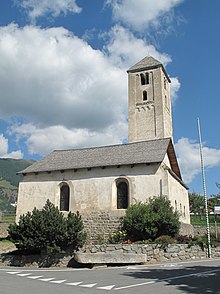St. Benedict (Mals)
St. Benedikt is a pre-Romanesque church in Mals in South Tyrol . It is known for its Carolingian frescoes from the 8th or 9th century. The Roman Catholic sacred building is consecrated to Saint Benedict of Nursia .
history
The construction of the church goes back to the second half of the 8th century. As a separate church it belonged to the Bishop of Chur until the 12th century . In the 12th century, the hall church was completely covered and the Romanesque church tower was added. Under Joseph II , St. Benedict was profaned and subsequently used as a storage room. It was not until the 20th century that the church was reopened to the public after its exceptional art-historical value had been discovered.
Building description
St. Benedict is a simple rectangular building, the church tower is built laterally in the north. On the west side there is a bricked up arched door with a bricked round window above. The south side presents itself with a round arched door and two round arched windows. To the east, the church building shows three slit-like arched windows. Inside the church, behind these arched windows on the east wall, there are three altar niches, the original stucco design (columns, capitals, animal bodies, arches) still preserved in small remnants. The square tower is divided into three floors and is closed off by a low square pyramid.
Frescoes
St. Benedict is famous for the frescoes created around 800, which is one of the very sparsely scattered evidence of Carolingian wall painting in Europe. The works can be seen in connection with the frescoes of the same age from the nearby Benedictine monastery of St. Johann in the Grisons Münstertal (Val Müstair) as well as some other sacred buildings in northern Italy.
The majority of the preserved wall painting is on the altar wall, which is divided by the three niches. Jesus Christ is shown in the middle niche, Pope Gregory the Great in the north and Stephen in the south .
On the two partition walls between the three niches are pictures of the donors: on the north a noble landlord, "the only representation of a Franconian landlord in costume in Europe", on the south a clergyman holding a model of a hall church in his hands. Above it is a twelve-man band of angels . The north wall was painted with scenes showing Pope Gregory: Gregory writing his dialogues inspired by the Trinity , Gregory during a disputation with Paulus Deaconus . In addition, depictions from the life of Paul of Tarsus and a fragment of a Benedictine legend can be seen.
literature
- Leo Andergassen : South Tyrol: art on site . Athesia, Bozen 2002, ISBN 978-8882661113 , p. 145
- Oskar Emmenegger, Helmut Stampfer : The wall paintings of St. Benedikt in Mals in the light of a technical examination . In: The art and its preservation , Worms 1990, pp. 247–268
- Mathias Frei: St. Benedikt in Mals (= SB color art guide South Tyrol; 3 ). SB-Verlag, Bozen 1995, ISBN 88-85129-05-6
- Hans Nothdurfter: St. Benedict in Mals . Tappeiner, Lana 2002, ISBN 88-7073-315-7
- Elisabeth Rüber: St. Benedikt in Mals (= European university publications, series 28, art history; 130 ). Lang, Frankfurt am Main 1991, ISBN 3-631-44189-4
- Elisabeth Rüber: Saint Benedict in Malles . Athesia, Bozen 1992, ISBN 88-7014-686-3
Web links
- Entry in the monument browser on the website of the South Tyrolean Monuments Office
supporting documents
- ↑ Nina Schneeberger: The attractions of the Vinschgau , in: Neue Zürcher Zeitung , March 16, 2017.
Coordinates: 46 ° 41 ′ 25.2 ″ N , 10 ° 32 ′ 22.3 ″ E






